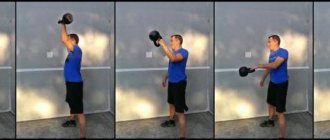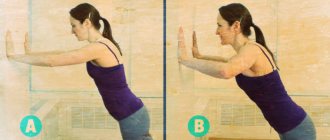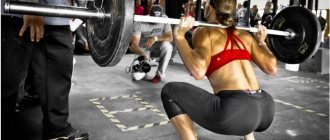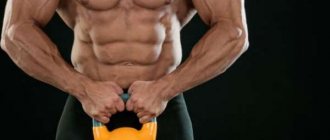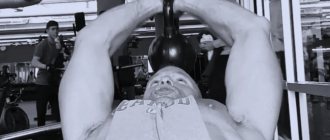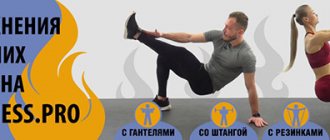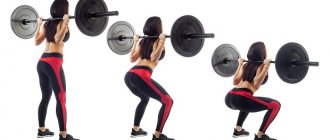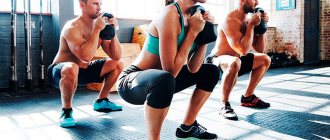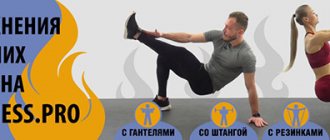What muscles work when swinging kettlebells?
Swings or swings with a kettlebell are a multifunctional exercise that involves a large number of muscles and joints, develops endurance and strength. Thus, kettlebell swings will help burn fat when performing a high number of repetitions and maximum speed, that is, for a while.
In the first half of the range of motion, the quadriceps of the thigh and buttocks work, which contribute to pushing the weight out during the swing. The muscles of the abdomen and lower back are in static, that is, constant tension, which perform the function of protecting the spine from injury and also help push out the weight. In the lower position of the movement, the weight rises by inertia, thanks to the swinging of the body and pushing out by the pelvis. In the middle of the amplitude, the deltoid muscles, and to a greater extent the anterior bundles, are activated.
There are two ways to perform the exercise:
- Raising a kettlebell to a parallel line with the floor, such kettlebell swings are called Russian.
- Kettlebell overhead swings are used in CrossFit, this technique comes from the West.
The last option, from a technical point of view, is considered unjustified, since the deltas are no longer involved when moving above the parallel of the floor. However, this is the correct technique when meeting CrossFit standards.
Exercise technique
Not only the severity of the results obtained, but also the safety of your joints, muscles and spine depend on how accurately you follow the technique.
CrossFit: performing two-arm swings.
Let's look at the correct execution of swings:
- Initial position. Feet shoulder-width apart, knees slightly bent, pelvis laid back, back straight. The weight stands in front, the distance from it to the toe line is approximately equal to the length of the foot.
- Next, your task will be, while maintaining a straight back, to detonate the projectile from the ground and swing back. At the bottom of the trajectory, your body should be almost parallel to the floor. You perform the movement for the most part due to rotation in the hip joints. The knees bend and straighten slightly, the back participates indirectly in the movement.
- When the weight begins to fall after the swing, you need to move it forward with an accentuated movement - make a jerk. In this case, at the beginning of the movement, the weight is transferred from the heels to the forefoot, the knees bend and move slightly forward. Acceleration of the kettlebell is achieved through a sharp, powerful movement of the pelvis and contraction of the gluteal muscles. As the kettlebell flies up, the weight shifts back slightly again.
- After reaching the top point (at shoulder level), the projectile is lowered into a repeated swing. If you perform an exercise with one hand and need to change it, the interception occurs after the projectile passes the highest point of the amplitude. This exercise does not involve lifting weights above you. After reaching the dead center, the projectile falls down.
Important technical aspects:
- The kettlebell moves along an arc path that passes at or above the level of the knees, closer to the groin. The back is in the same position all the time - flexion or extension of the spine is not allowed. The pelvis moves forward at the beginning of the movement and moves back at the end with a small amplitude.
- Throughout the entire movement, the buttock muscles are tense. You can relax them a little only when the weight returns from the top point.
- The arms are straight, they do not take an active part in the work. Kettlebell swings are accomplished largely through explosive force from the hips and buttocks.
- The neck forms a single line with the spine. Under no circumstances should you bend it or throw your head back when moving.
The main purpose of performing swings is to strengthen the muscles of the lower body and develop the correct technique for moving the pelvis (flexion at the hip joint). This turns out to be a significant help when performing squats and deadlifts. This exercise will be useful to you no matter what you prefer: weightlifting, team sports or CrossFit.
When working with heavy weights, swings are performed with two hands. This makes the load more even.
Many functional exercises with kettlebells from weightlifting have migrated to CrossFit.
Important!
- When swinging, the lumbar spine is subjected to a lot of stress; you must follow the correct technique, keep the abdominal muscles, lower back, and buttocks tense.
- Working with too much kettlebell weight can injure the shoulder joint; for this, select a moderate weight of the kettlebell.
- Do not round your back in the thoracic region, keep your shoulder blades tucked in, and do not twist your shoulders forward.
For injuries and diseases of the spine, kettlebell swings are contraindicated.
Common Mistakes
The exercise must be done strictly according to the rules. Otherwise, it will not be possible to achieve the desired result. In addition, instead of the expected benefit, physical activity can cause harm. It is worth considering the most common mistakes to avoid making them:
- Performing squat exercises follows the same principle as a squat.
- Flexion of elbows and hands.
- Lifting the projectile by tensing the deltoid muscles.
- Rounding the back.
- Relaxation of the abdomen.
- Insufficient hip work. The athlete tries to push the projectile out only by straightening his knees.
The main mistake that beginners make is replacing the kettlebell with some other type of weight. This exercise becomes ineffective in such a situation. Training will give the desired result only if you use the right sports equipment.
The problem is that a large assortment of equipment of different weights is presented only in gyms. Therefore, people try to replace them with improvised means, making a huge mistake. If you can't find the right equipment, it's better to do other strength training options. Once your physical fitness improves, you can return to swings using heavier kettlebells.
Rounding your back and relaxing your stomach are common mistakes when performing kettlebell swings.
It is incorrect to lift the apparatus by tensing the deltoid muscles
You cannot replace the kettlebell with other equipment; in this case, the exercise becomes ineffective.
Where to start for a beginner
Before starting to practice the exercise technique, warm up your muscles, ligaments and joints. Spend 7-10 minutes warming up (running, jumping rope). Stretch your glutes, glutes, and back muscles. Rotate your arms to warm up your shoulder joints, and also warm up your hip joint.
Perform the hyperextension exercise; this will stretch and tone the lumbar extensors, forming a protective “corset” necessary for training with kettlebells.
Choose a minimum kettlebell weight to begin with, work on the quality of your technique, not on your strength.
Remember , in order to perform swings efficiently, not only your back and abs must be strong, but also your legs, buttocks, and deltoids. Therefore, first you need to tone all your muscles in order to feel and correctly distribute the load on them.
Challenges in research using weights
Over the past year, there has been a ton of research done using kettlebells. However, in my opinion, these studies are practically useless.
Imagine if you were faced with the emergence of a large number of studies using dumbbells, however, these studies would only use five- and 10-kg dumbbells on adult men. “Stupid, use heavier weights,” you might think. This is exactly the situation I see with kettlebell research - very low weights for the hips!
Meanwhile, a recent study by Lake and Lauder used a 32kg kettlebell and is by far the best work I've seen (showing that swings generate higher momentum than squats) or jump squats). And yet, this is only an exception to the rule.
Besides, 32 kilograms is not that much. I want to see training studies using really heavy kettlebells to evaluate their impact on athletic performance.
I understand that people most often use relatively light kettlebells because they want to perform cleans, snatches, presses, and Turkish get-ups with them. Also, using lighter weights on your swings makes a lot of sense at first.
However, as athletes improve their performance in the kettlebell swing, it is necessary to gradually increase the load. And I know that most gyms don't have very heavy weights, so I encourage you to take action!
Sports equipment manufacturers need to start mass producing truly heavy weights, and athletes, coaches and gym owners need to start buying them. In the meantime, at the end of this article I will still present several options that allow you to perform heavy swings.
Kettlebell swings with two hands: technique
- Grasp the handle of the weights with both hands, place your feet slightly wider than your pelvis, with your toes slightly turned to the sides.
- Rock your body so that when you move forward, your pelvis seems to push your straight arms with the weight up. From the bottom point, the kettlebell starts moving between the thighs, from under the pelvis.
- As you push the weight up, tighten your glutes and straighten your knees and torso completely.
- Push the weight up to eye level, exhaling at the top.
- As you inhale, “throwing” the weight down, tilt your body forward so that the weight passes under your pelvis and, by inertia, returns upward, also completely straightening your torso.
Technique option No. 2
When swinging in CrossFit, the weight is pushed up to the top point above your head. Thus, also by inertia, the weight “flies” up and stops above the top of the head, forming a straight line of arms with the body. The body is completely straightened. When moving down, the weight is also placed under the pelvis.
Typical beginner mistakes
Exercises can be included in the training program only if there are no problems with joints and ligaments, otherwise the situation may worsen. It is important to choose the right optimal weight, which will ensure a reasonable load and eliminate the risk of injury. It is necessary to increase the load gradually, first varying the number of repetitions, and then increasing the weight of the projectile.
Some of the most common errors in kettlebell swing technique include:
- I don’t perform swings without preliminary warm-up;
- it is allowed to relax the gluteal muscles at the top point of the projectile, which leads to its lowering too sharply;
- lifting the weights too high;
- incorrect breathing, when “tearing” the projectile to the top, you must exhale, when moving backward by inertia, you must exhale and when moving to the top point, exhale again;
- lifting of the heels from the floor surface, as a result of which control over the projectile is lost, the danger lies in the possibility of falling and getting a back injury;
- deviation of the trajectory from a straight vertical line;
- looking down or throwing your head back.
It is necessary to start swinging with kettlebells with your weakest hand, which allows you to evenly load the muscles. You should not reach a phase of muscle failure, so you must resort to a gradual increase in load and do not forget about rest between approaches. For classes you need to choose the “right” type of shoes. The sole must be flat and non-slip; swinging in slates is prohibited.
Kettlebell swings belong to the category of exercises that allow you to warm up your muscles before training and provide a complex load to a large number of muscle groups. Due to the ability to vary the weight of the projectile, it is possible to use the exercises for both beginners and professional athletes. The success and effectiveness of classes largely depends on the correct technique and compliance with safety standards.
Benefits of exercise
Two-handed kettlebell swings are a useful multifunctional exercise that is simultaneously responsible for explosive leg strength, maintaining static tension in the core muscles, and developing strength endurance and grip strength. For these reasons, this exercise has gained enormous popularity not only in CrossFit and kettlebell lifting, but also in mixed martial arts, Brazilian jiu-jitsu, grappling and other types of martial arts. Some athletes who are interested in fitness and bodybuilding also include this exercise in their training program, which leads to increased strength in such common exercises as classic and front squats with a barbell, deadlifts, military presses, shrugs and others. Therefore, the benefits of kettlebell swings cannot be overestimated.
Description of the exercise
This exercise is great for losing weight and warming up muscles; you won’t be able to pump up your body muscles too much, but it’s an excellent way to warm up. Also, training with a kettlebell will allow you to burn a lot of calories; after prolonged exercise, your T-shirt will be wringable from moisture. So girls need to take note of this point, and beginners as the initial stage of strengthening the large muscles of the body.
All muscle groups are warmed up - legs, arms, back, if there is no weight, you can use a dumbbell, clasping it with both hands, of course this is not very convenient, but it will do as an alternative.
Diagonal swing
There is no point in practicing this version of the swing in kettlebell fitness, so we will consider the option only for kettlebell lifting. The use of a diagonal swing in the snatch allows you to reduce the rotational load on the thoracic and lumbar spine, as well as lengthen the amplitude of the backswing. In its structure, it practically coincides with the Russian one-arm swing for kettlebell lifting.
The difference is that the plane of movement of the working hand with the weight is rotated from the sagittal plane in the same direction at an angle of up to 45-50 degrees.
At the end point of the backswing, the athlete’s body weight is completely transferred to the leg of the same name in the working arm, and the heel of the opposite leg comes off the platform ( Fig. 11 ).
Rice. 11. End point of backswing
At the end point of the forward swing, the athlete’s body weight is completely transferred to the leg opposite the working hand, and the heel of the same leg comes off the platform ( Fig. 12 ).
Rice. 12. End point of forward swing
Why do you need a kettlebell in training?
The kettlebell, as a sports equipment, has been known in Russia since the end of the 17th century. For the first time, soldiers practiced with it, for whom cannonballs were cast together with a comfortable handle - this made it easier to grab the weight and perform various techniques with its help.
From the military environment, weights became an indispensable attribute of fun fairs. With its help, mighty heroes demonstrated dashing tricks to the public.
As is the case with any available sports equipment, such as dumbbells, a fitball or a foam roller, you can perform exercises with weights at home, in a clearing in a park, in the yard - in general, wherever there is a small patch of free space.
